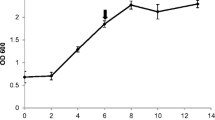Abstract
Ethylene production in leaves of susceptible and hypersensitive varieties of beans has been followed after inoculation with Uromyces phaseoli. Four different states of ethylene evolution are distinguishable: (1) 13 h after inoculation and concomitant to the penetration of the fungal mycelium through the stomata, all varieties show an outburst of ethylene with significant differences between the three varieties. (2) After 36 h postinoculation, in all three varieties ethylene evolution is scarcely higher than in noninfected leaves. (3) Starting 59 h after inoculation, only in the hypersensitive variety 765 (which shows the lowest ethylene production after 13 h), a second, very strong ethylene outburst is observed. (4) From 125 h after inoculation, significant ethylene production is not observed in any variety. At this time, characteristic symptoms are expressed in susceptible leaves (differentiation of uredosori) and in the hypersensitive variety 765 (large brown necrotic spots); no macroscopic symptoms are observed in the hypersensitive variety 814, which exhibits the strongest ethylene outburst 13 h after inoculation. The capacity for ethylene formation after mechanical wounding (“point freezing”) is almost identical in healthy leaves of all three varieties. This capacity is still preserved after the first ethylene outburst 36 h after infection.
Similar content being viewed by others
References
Abeles, F.B.: Ethylene in plant biology. London-New York: Academic Press 1973
Balázs, E., Gáborjányi, R., Toth, Á., Király, Z.: Ethylene production in xanthi tobacco after systemic and local virus infections. Acta Phytopathol. Acad. Sci. Hung. 4, 355–358 (1969)
Chalutz, E., De Vay, J.E.: Production of ethylene in vitro and in vivo by Ceratocystis fimbriata in relation to disease development. Phytopathology 59, 750–755 (1969)
Daly, J.M., Seevers, P.M., Ludden, P.: Studies on wheat stem rust resistance controlled at the Sr6 locusl. III. Ethylene and disease reaction. Phytopathology 60, 1648–1652 (1970)
Elstner, E.F., Konze, J.R.: Effect of point freezing on ethylene and ethane production by sugar beet leaf disks. Nature 263, 351–352 (1976)
Freebairn, H.T., Buddenhagen, I.W.: Ethylene production by Pseudomonas solanacearum. Nature 202, 313–314 (1964)
Gentile, I.A., Matta, A.: Production of and some effects of ethylene in relation to Fusarium wilt of tomato. Physiol. Plant Pathol. 5, 27–37 (1975)
Marte, M., Montalbini, P.: Microfluorescenza in foglie de fagiolo suscettibile e resistente alla ruggine. Phytopathol. Z. 75, 59–73 (1972)
Mendgen, K., Heitefuss, R.: Micro-autoradiographic studies on host—parasite interactions. I: The infection of Phaseolus vulgaris with tritium labeled uredospores of Uromyces phaseoli. Arch. Microbiol. 105, 193–199 (1975)
Nakagaki, Y., Hirai, T., Stahmann, M.A.: Ethylene production by detached leaves infected with tobacco mosaic virus. Virology 40, 1–9 (1970)
Pegg, G.F., Cronshaw, D.K.: Ethylene production in tomato plants infected with Verticillium albo-atrum. Physiol. Plant Pathol. 8, 279–295 (1976)
Pratt, H.K., Goeschl, J.D.: Physiological roles of ethylene in plants. Ann. Rev. Plant Physiol. 20, 541–584 (1969)
Ross, A.F., Williamson, C.E.: Physiological active emanation from virus-infected plants. Phytopathology 41, 431–438 (1951)
Sempio, C., Caporali, L.: L'Uromyces Appendiculatus sul fagiolo e su altre specie: Virulenza e specializzazione. Ann. Fac. Univ. Perugia XIII, 233–277 (1958)
Smith, W.H., Meigh, D.F., Parker, J.C.: Effect of damage and fungal infection on the production of ethylene by carnation. Nature 204, 92 (1964)
Stahmann, M.A., Clare, B.G., Woodbury, W.: Increased disease resistance and enzyme activity induced by ethylene and ethylene production by black rot infected sweet potato tissue. Plant Physiol. 41, 1505–1512 (1966)
Williamson, C.E.: Ethylene, a metabolic product of diseased or injured plants. Phytopathology 40, 205–208 (1950)
Author information
Authors and Affiliations
Additional information
This work was supported by the Deutsche Forschungsgemeinschaft, by the Kleinwanzlebener Saatzucht AG (Einbeck, FRG) and by a NATO fellowship to P.M.
Rights and permissions
About this article
Cite this article
Montalbini, P., Elstner, E.F. Ethylene evolution by rust-infected, detached bean (Phaseolus vulgaris L.) leaves susceptible and hypersensitive to Uromyces phaseoli (Pers.) Wint.. Planta 135, 301–306 (1977). https://doi.org/10.1007/BF00384904
Received:
Accepted:
Issue Date:
DOI: https://doi.org/10.1007/BF00384904




